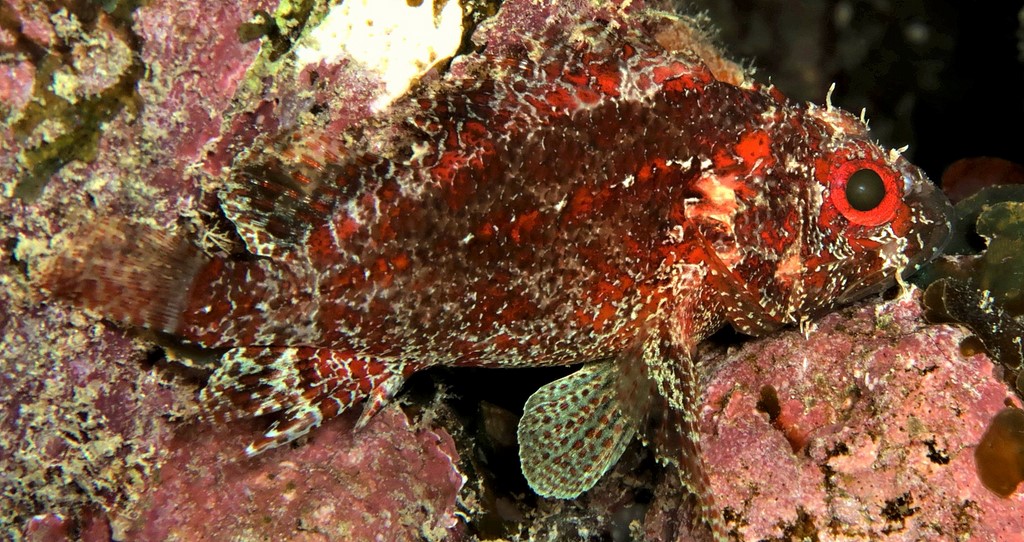SCORPAENODES GUAMENSIS - (QUOY & GAIMARD, 1824)
Picture courtesy of: Alain Daoulas
Actinopterygii (Gigaclass) > Actinopteri (Class) > Teleostei (Subclass) > Perciformes (Order) > Scorpaenoidei (Suborder) > Scorpaenidae (Family) > Scorpaeninae (Subfamily) > Scorpaenodes (Genus)
Poisson scorpion de Guam, Guam scorpionfish, Common scorpionfish, Guamse skerpioenvis, Guamukasago, グアムカサゴ, 关岛小鲉, 石狗公,
Synonymes
Centropogon echinatus (Macleay, 1881)
Scorpaena chilioprista (Rüppell, 1838)
Scorpaena erinacea (Garman, 1903)
Scorpaena guamensis (Quoy & Gaimard, 1824)
Scorpaena polylepis (Bleeker, 1851)
Scorpaena rubropunctata (Cuvier, 1829)
Scorpaenodes guamnsis (Quoy & Gaimard, 1824)
Scorpaenopsis quiescens (Seale, 1906)
Sebastes minutus (Cuvier, 1829)
--------------------------
Description
Dorsal spines (total): 13-14; Dorsal soft rays (total): 7-9 (usually: 8); Analspines: 3; Analsoft rays: 5; Pectoral-fin rays: 17-20 (usually: 18), some rays branched in specimens over ca. 40 mm SL; Pelvic fin rays: I, 5; Scale rows in longitudinal series: 40-46 (usually: 43); Underside of lower jaw scaleless; Gill rakers 11-15 (usually: 13); With nasal spine; Lateral lacrimal spine is usually present; Suborbital spines: 2, first spine below eye, second spine at end of suborbital ridge; No interorbital and coronal spines; Opercle with a large dark blotch; No dark blotch on subopercle or spinous portion of dorsal fin. Max. length: 14.0 cm TL. Depth range: 0 - 20 m, usually 0 - 5 m.
Color
Body color variable, mottled with reddish to grayish. A large dark spot on opercle; No dark spot at rear of spinous portion of dorsal fin or subopercle; No dark triangular mark at pectoral-fin base.
Etymology
Scorpaenodes: from ancient Greek, skórpaina = scorpion, name of Scorpaena scrofa + from Greek suffix, -oides = resembling, similar to. Referring to its dorsal-fin spines, which can inflict a painful wound, like the sting of a scorpion.
guamensis: name from the type locality, Guam, Mariana Islands, western Pacific.
Original description: Scorpaena guamensis Quoy & Gaimard, 1824 - Type locality: Guam, Mariana Islands, western Pacific.
Distribution
Red Sea; Indo-West Pacific: East Africa, South Africa, Madagascar and Mascarenes east to Wake, Marshall and Marquesas islands, north to southern Japan, south to northwestern Australia, New South Wales (Australia), New Caledonia, Norfolk Island, Kermadec Islands, and Tonga.
Biology
Found in rock crevices in reef flats, shallow lagoons, and channels. Feeds mainly at night on small shrimps, crabs, and polychaetes. Anterolateral glandular groove with venom gland. Solitary and cryptic.
Last update: 27, March 2022
Actinopterygii (Gigaclass) > Actinopteri (Class) > Teleostei (Subclass) > Perciformes (Order) > Scorpaenoidei (Suborder) > Scorpaenidae (Family) > Scorpaeninae (Subfamily) > Scorpaenodes (Genus)
Poisson scorpion de Guam, Guam scorpionfish, Common scorpionfish, Guamse skerpioenvis, Guamukasago, グアムカサゴ, 关岛小鲉, 石狗公,
Synonymes
Centropogon echinatus (Macleay, 1881)
Scorpaena chilioprista (Rüppell, 1838)
Scorpaena erinacea (Garman, 1903)
Scorpaena guamensis (Quoy & Gaimard, 1824)
Scorpaena polylepis (Bleeker, 1851)
Scorpaena rubropunctata (Cuvier, 1829)
Scorpaenodes guamnsis (Quoy & Gaimard, 1824)
Scorpaenopsis quiescens (Seale, 1906)
Sebastes minutus (Cuvier, 1829)
--------------------------
Description
Dorsal spines (total): 13-14; Dorsal soft rays (total): 7-9 (usually: 8); Analspines: 3; Analsoft rays: 5; Pectoral-fin rays: 17-20 (usually: 18), some rays branched in specimens over ca. 40 mm SL; Pelvic fin rays: I, 5; Scale rows in longitudinal series: 40-46 (usually: 43); Underside of lower jaw scaleless; Gill rakers 11-15 (usually: 13); With nasal spine; Lateral lacrimal spine is usually present; Suborbital spines: 2, first spine below eye, second spine at end of suborbital ridge; No interorbital and coronal spines; Opercle with a large dark blotch; No dark blotch on subopercle or spinous portion of dorsal fin. Max. length: 14.0 cm TL. Depth range: 0 - 20 m, usually 0 - 5 m.
Color
Body color variable, mottled with reddish to grayish. A large dark spot on opercle; No dark spot at rear of spinous portion of dorsal fin or subopercle; No dark triangular mark at pectoral-fin base.
Etymology
Scorpaenodes: from ancient Greek, skórpaina = scorpion, name of Scorpaena scrofa + from Greek suffix, -oides = resembling, similar to. Referring to its dorsal-fin spines, which can inflict a painful wound, like the sting of a scorpion.
guamensis: name from the type locality, Guam, Mariana Islands, western Pacific.
Original description: Scorpaena guamensis Quoy & Gaimard, 1824 - Type locality: Guam, Mariana Islands, western Pacific.
Distribution
Red Sea; Indo-West Pacific: East Africa, South Africa, Madagascar and Mascarenes east to Wake, Marshall and Marquesas islands, north to southern Japan, south to northwestern Australia, New South Wales (Australia), New Caledonia, Norfolk Island, Kermadec Islands, and Tonga.
Biology
Found in rock crevices in reef flats, shallow lagoons, and channels. Feeds mainly at night on small shrimps, crabs, and polychaetes. Anterolateral glandular groove with venom gland. Solitary and cryptic.
Last update: 27, March 2022
